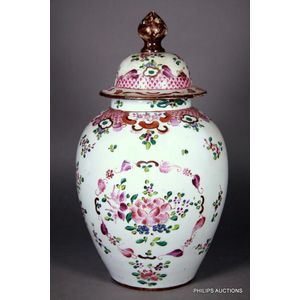Qing Dynasty Famille Rose Covered Jar
You must be a subscriber, and be logged in to view price and dealer details.
Subscribe Now to view actual auction price for this item
When you subscribe, you have the option of setting the currency in which to display prices to $Au, $US, $NZ or Stg.
- Qing Dynasty - The Qing Dynasty was the last imperial dynasty of China, ruling from 1644 to 1912. It was established by the Manchu people, who originated from the northeastern region of China. The Qing Dynasty was preceded by the Ming Dynasty and followed by the Republic of China.
- Ming Dynasty - The Ming Dynasty was a ruling dynasty of China from 1368 to 1644. It succeeded the Yuan Dynasty and preceded the Qing Dynasty. The Ming Dynasty was established by Zhu Yuanzhang, a former Buddhist monk who became a rebel leader and eventually overthrew the Mongol Yuan Dynasty. During the Ming Dynasty, China experienced a period of relative stability and prosperity. The government was centralized and bureaucratic, with the emperor at the top of the hierarchy. The Ming Dynasty is known for its cultural achievements, including the development of porcelain, the invention of movable type printing, and the construction of the Great Wall of China.
- Diaper Motif - The diaper motif is a repeating geometric pattern in decorative arts that consists of small diamond or lozenge shapes arranged in a grid. The pattern is often used as a background or border on textiles, ceramics, metalwork, and other decorative items. It can be found in a variety of cultures and historical periods, and is often used in formal or ornamental designs. The name "diaper" comes from the pattern's resemblance to the criss-crossed fabric of a baby's diaper.
- Oviform /ovoid - The outline loosely resembling the shape of an egg.
This item has been included into following indexes:
Visually similar items

A Royal Crown Derby covered vase, 1914, of oval and lobed form with a compressed globe cover and pointed finial, decorated with underglaze blue decoration and painted sprigs and roses in enamel colours, the neck, and cover with moulded decoration in a thin

A Chinese blue-and-white 'dragon' jar with cover, Late Ming dynasty 19.5 cm high (2). Provenance: NSW Private Collection. Raymond and Victoria Tregaskis (label)

A Chinese ribbed covered porcelain vase. The tapering ovoid vase with a high domed lid with a ruffled edge and knop finial, decorated with flowers and ribbons in a basket in iron red and cobalt colours, the collar with floral motifs to alternate red and bl

A Japanese Satsuma jar, Meiji period (1868-1912), well decorated in soft enamels, a raised wired enamel with swallows and flowering chrysanthemums brushes, a stylized band decorated below the neck, signed two characters gilt mark 'Meizan'. 15 cm high . Pro
